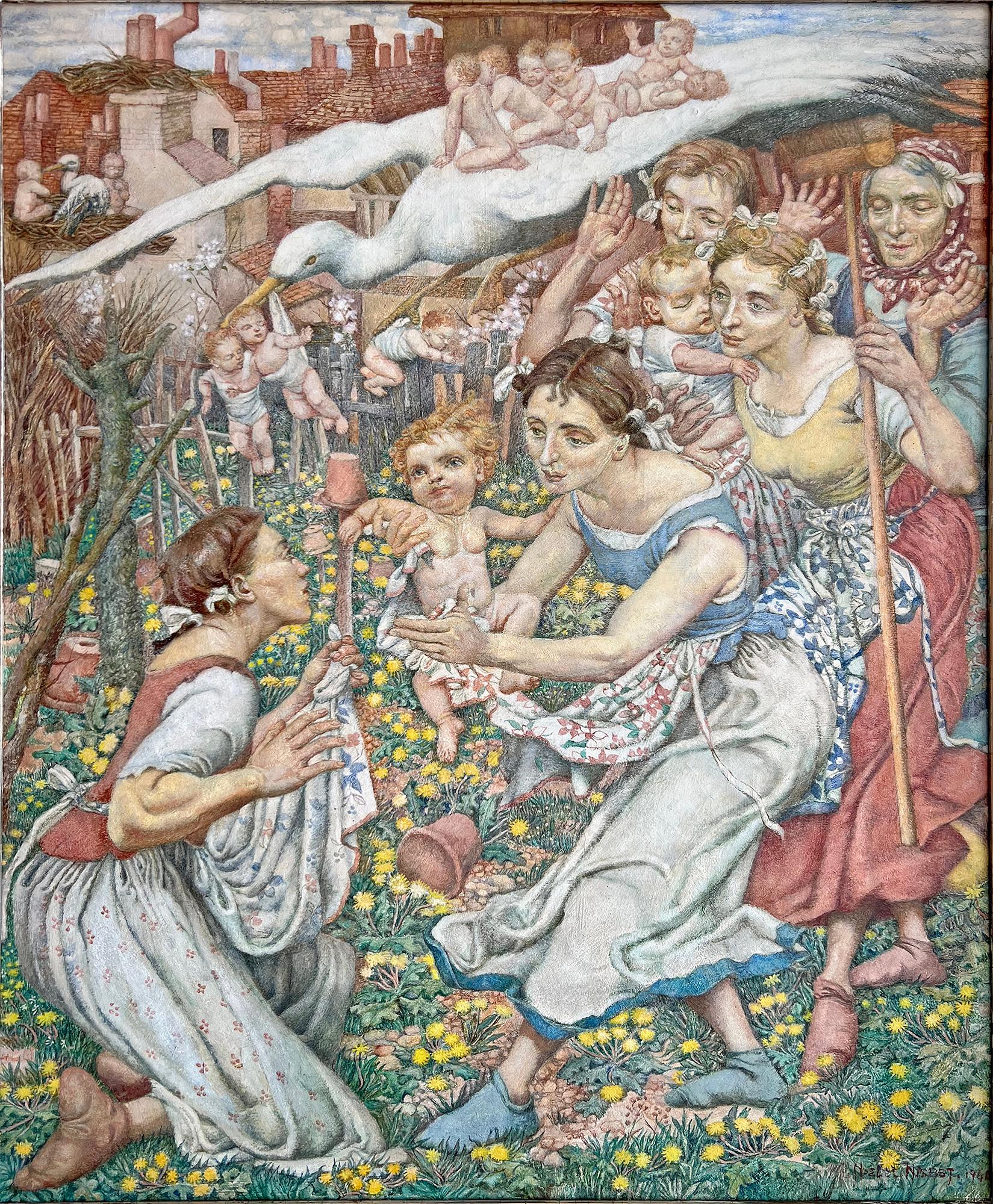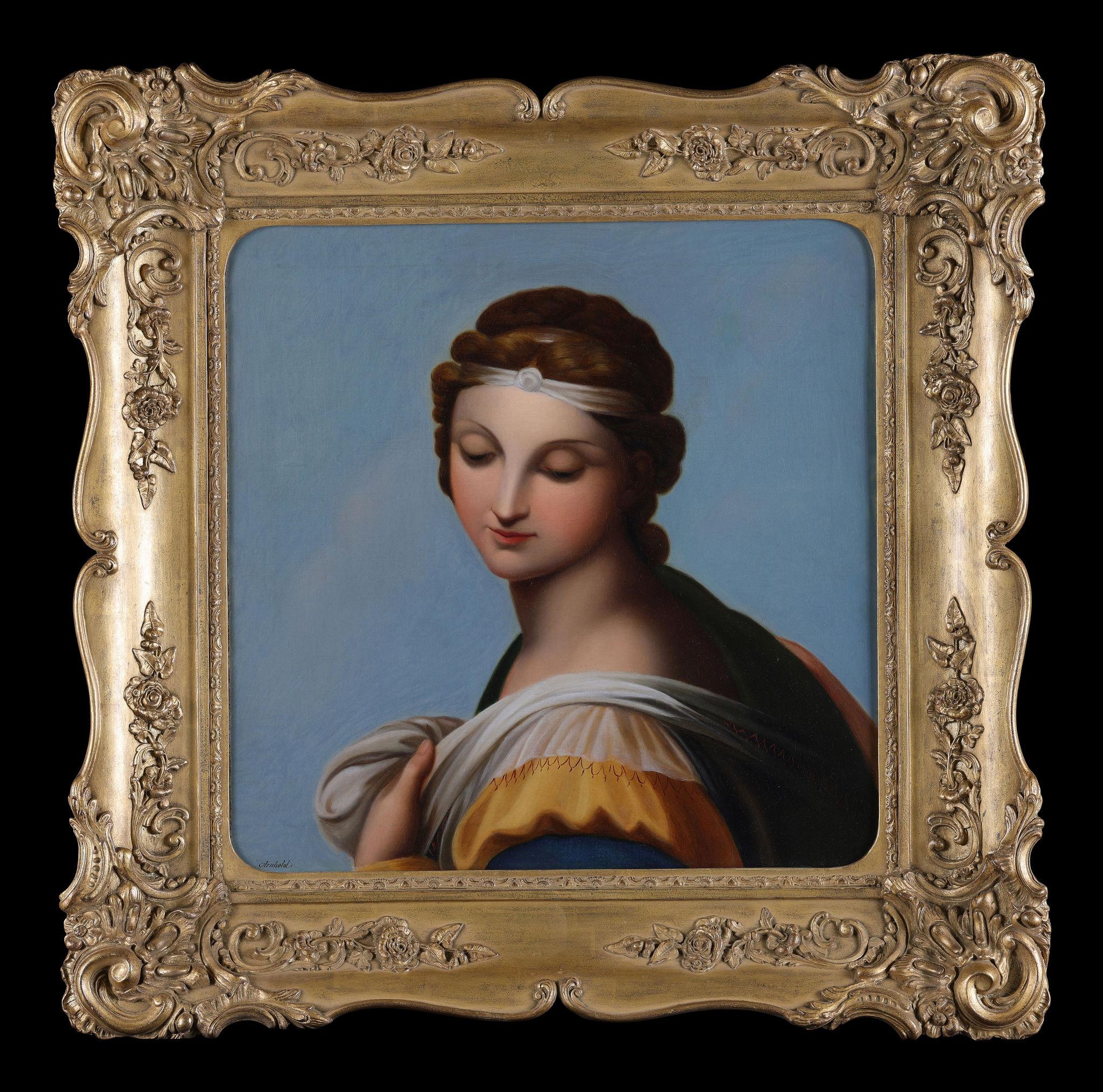Items Similar to Self Portrait, 19th Century Pre-Raphaelite Oil Painting
Want more images or videos?
Request additional images or videos from the seller
1 of 3
19th century British SchoolSelf Portrait, 19th Century Pre-Raphaelite Oil Painting
About the Item
Oil on canvas
Image size: 9 1/4 x 7 inches (23.5 x 18 cm)
Original pierced gilt frame
This wonderful Pre-Raphaelite self-portrait contributes to the artistic tradition of representing one's self through visual means, a tradition that stretches back to the time of Ancient Egypt.
Throughout the course of art history self-portraiture has remained a tried and true practice among leading artists. Self portraits can provide a fascinating glimpse into an artist's personality, professional ambition and their social success.
This self portrait is an exercise in technique as well as personal self-examination. The artist's soft eyes and relaxed body language welcome us into the scene we are presented with. The exquisite detail that the artist has achieved with the oil paint is captivating - look at the individually crafted hairs that punctuate the man's chin. This detail adds to the atmosphere of the scene, as does the warm lighting with which the artist has been lit. The light illuminates the artist's face as he turns to the viewer while creating a shadow across his jawline. A glowing aura is also formed around his figure, allowing the artist to exude a stage-like presence.
- Creator:19th century British School
- Dimensions:Height: 9.25 in (23.5 cm)Width: 7 in (17.78 cm)
- More Editions & Sizes:1 of 1Price: $6,883
- Medium:
- Movement & Style:
- Period:
- Condition:
- Gallery Location:London, GB
- Reference Number:1stDibs: LU52410975462
About the Seller
5.0
Vetted Seller
These experienced sellers undergo a comprehensive evaluation by our team of in-house experts.
Established in 2007
1stDibs seller since 2014
63 sales on 1stDibs
Typical response time: 2 hours
- ShippingRetrieving quote...Ships From: London, United Kingdom
- Return PolicyA return for this item may be initiated within 14 days of delivery.
More From This SellerView All
- Portrait of a Young Woman, 19th Century Pre-Raphaelite Oil on CanvasLocated in London, GBLouisa Starr 1845 - 1909 Portrait of a Young Woman Oil on canvas, monogrammed Image size: 8 ½ x 6 ¼ inches (22 x 16 cm) Pre-Raphaelite style frame Provenance Family Estate Christies Private Estate This rare beautiful portrait is clearly influenced by the Pre-Raphaelites, who were friends of Louisa Starr. The Pre-Raphaelites often included symbolic elements in their work, and the background of ivy in this painting, symbolising everlasting life, is a reference to that. This is an early work by Starr as she uses her monogram of a letter L with a star, which can be seen bottom right. The photograph below shows the painting in her studio, top left. The Artist Louisa Starr was born in Liverpool of American descent. Starr attended Heatherley's Art School. During this period artistic training was dominated by the Royal Academy Schools, which gave students a rigorous grounding in life-drawing and painting, presided over by Frederick Leighton and staffed by some of the leading artists of the time. Competition to enter the RA schools was very great, and at sixteen Louisa Starr became the youngest student ever to attend, being one of two students selected out of thirty eight entrants. The fact that she was a woman is very significant. She signed her work 'L Starr' so that her gender was not apparent, and when her identity became known, she was told that it was not permitted by the constitution to admit female students. (Women had attended the RA Schools before but not in any great number and not for some time). When she asked to see the clause, it could not be found, and they ended up admitting six women students so that they could chaperone each other. She had an outstanding career as a student, winning a Silver medal for the best copy of Murillo's 'Beggars' in 1865 - which was the first medal ever awarded by the RA to a woman, and a Gold medal for the most successful historical painting in 1867. She met her future husband, Enrico Canziani, an Italian cousin, whilst visiting relatives in Italy. Her independent outlook and progressive thinking were somewhat at odds with traditional Italian village life, but Enrico understood and encouraged her work by setting up a studio space and helping to find local models for her to paint. He was a civil engineer, who had built a sugar refinery in Italy and established paper-mills and chemical product factories. They married in Dover in 1882, when Starr was thirty seven, and her attitude to life and work continued to be assertive and uncompromising. For example, she removed the 'obey' from the marriage service, and it was decided that she would continue to live and work in England, and Enrico would be the one to move. He settled in England, but as much of his business was in Italy he continued to visit at least three times a year. Their daughter Estella was born in 1887. She became a portrait and landscape painter, an interior decorator and a travel writer and folklorist. Estella reports that her mother dreamed of an ideal house and recognised it while driving in Kensington Gardens, seeing a board up advertising it to let. She telegraphed to her husband to come back from Paris and they secured the property just five minutes ahead of a gentleman who was also waiting for the office to open. Estella was born there two years later. The address was 3 Palace Green, Kensington. Louisa was good friends with many of the prominent artists of the day including Frederick Lord Leighton, Val Princep and his family who lived next door to Leighton as well as G F Watts...Category
1850s Pre-Raphaelite Portrait Paintings
MaterialsOil
- Portrait of a Sleeping Woman Original Oil Painting Modern BritishBy Lionel EllisLocated in London, GBLionel Ellis 1903 - 1988 Portrait of a Sleeping Woman Oil on canvas Image size: 14 x 18 inches (35.5 x 45.5cm) Framed Lionel Ellis ARCA (1903-1988) was a...Category
20th Century Portrait Paintings
MaterialsOil, Canvas
- The Distraction, Late 19th Century Oil Painting, OrientalistLocated in London, GBWalter Charles Horsley 1855 – 1921 The Distraction Oil on canvas, signed lower left Image size: 25 x 20 1/2 inches (63.5 x 52 cm) Orientalist ha...Category
Late 19th Century Portrait Paintings
MaterialsOil, Canvas
- Portrait of Sir Edward Littleton, First Baron Lyttleton, Old Masters OilBy (After) Anthony Van DyckLocated in London, GBAfter Sir Anthony van Dyck (1599-1641) Portrait of Sir Edward Lord Littleton, First Baron Lyttleton (1589-1645) Oil on canvas Image size: 96 by 76 cm Hand carved auricular frame Sir Edward Littleton was Solicitor-General to Charles I, 1634-40; Chief Justice of Common Pleas, January 1640-January 1641; Lord Keeper, 1641-45. Painted in his robes, and wearing the chain of office...Category
17th Century Old Masters Portrait Paintings
MaterialsOil, Canvas
- The Blue Headdress, Group Portrait Orientalist Oil Painting, Signed and DatedBy Emile DeckersLocated in London, GBÉmile Deckers 1885 - 1968 The Blue Headress Oil on canvas, signed lower left, inscribed and dated "Algers, 1958" Image size: 26 x 33 inches (66 x 84 cm) Hand made Orientalist gilt f...Category
1950s Portrait Paintings
MaterialsCanvas, Oil
- Portrait of a King's MessengerBy Charles PhilipsLocated in London, GBCharles Philips 1703 - 1747 Portrait of a King's Messenger Oil on canvas Image size: 35 ¾ x 28 inches Original gilt frame King's Messenger The job of a King's Messenger was that of a diplomatic courier, hand-carrying important and secret documents around the world. Some say that the history of the sovereigns' messengers goes back to 1199, but the first known messenger was John Norman, who in 1485 earned 4d (1½ pence) per day for carrying the state papers of Richard III. The silver greyhound on the messenger's badge dates back to Charles II. In 1660, during his exile at Breda, Netherlands, Charles II issued a declaration of amnesty to all those who had opposed him and his father. He used messengers to make his intentions known. In answer to the messenger's question "How will they know me?", Charles reached forward to a silver bowl on the table in front of him. This bowl, with four decorative greyhounds standing proud above the rim, was well known to all courtiers. Charles broke off a greyhound and gave it to the messenger as a guarantee that the message came from him. From that date, the King's Messenger always wore a silver greyhound around his neck. Later, dating from George II or III, a badge with the Royal Arms in enamel, with the greyhound suspended beneath, was worn. A George III example of the King's Messenger Badge, pre 1800, sold for over £30,000 pounds some years ago. The silver greyhounds were minted for each new reign, except the brief one of King Edward VIII. The sovereign's messengers were originally controlled by the Lord Chamberlain, being Messengers of the Great Chamber. When the Foreign Office was created in 1782, the messengers remained common to the three Secretaries of State. Charles Philips was an English artist known for painting a number of portraits and conversation pieces for noble and Royal patrons in the mid-eighteenth century. Philips was baptised in the combined parish of St Mildred, Poultry with St Mary...Category
18th Century Portrait Paintings
MaterialsOil, Canvas
You May Also Like
- Pre-Raphaelite Style Painting of Mothers and Babies in WWIILocated in Miami, FLBabies are falling from the sky and not bombs. British female artist and illustrator Noel Laura Nisbet makes a passionate twist to the reality of En...Category
1940s Pre-Raphaelite Figurative Paintings
MaterialsCanvas, Tempera, Mixed Media, Oil
- Antique English Pre-Raphaelite Oil Portrait of a Young Woman in Pensive ThoughtLocated in Cirencester, GloucestershireArtist/ School: English School Circa 1900 Title: Portrait of a young woman, head and shoulders Medium: oil on board, framed within an antique 'Florentine' gilt frame. actual pain...Category
19th Century Pre-Raphaelite Portrait Paintings
MaterialsOil
- A Pre-Raphaelite BeautyLocated in St. Albans, GBA wonderful painting of a beautiful woman in the style of the Pre-Raphaelites. It is signed Arnhold. It is in very condition and in the original frame. Picture Size: 21 x 21" (51 ...Category
1850s Pre-Raphaelite Portrait Paintings
MaterialsOil
- Portrait of a Young Girl in a White Dress - British Edwardian art oil paintingBy Robert Edward MorrisonLocated in London, GBThis lovely British Edwardian portrait oil painting is by noted Liverpool artist Robert Edward Morrison. Born on the Isle of Man, Morrison moved to Liv...Category
Early 1900s Pre-Raphaelite Portrait Paintings
MaterialsOil
- Portrait of a Girl Holding Wool - British Edwardian female portrait oil paintingLocated in London, GBThis beautiful British Edwardian portrait oil painting is by noted and much exhibited female artist Maud Marion Wear. Wear trained at the Royal Academy Schools in London for five yea...Category
Early 1900s Pre-Raphaelite Portrait Paintings
MaterialsOil
- Charity - Royal Academy exhib. 19thC art Pre-Raphaelite portrait oil paintingBy Rudolf LehmannLocated in London, GBThis stunning circular 19th century oil painting is by noted prolific Royal Academy exhibited artist Rudolf Lehmann. A portrait artist, German born Lehmann moved to England in 1866 w...Category
19th Century Pre-Raphaelite Portrait Paintings
MaterialsOil
Recently Viewed
View AllMore Ways To Browse
18th Or 19th Century Etchings
Antique Century
Centuries Antique
Century Antique
Century 9
Art Of The 19th Century
19th Century Scene
Portrait Of Self
British 19th
Artist Self Portrait
19th Century Man
British School Painting
Antique Oil Well
Oil On Canvas 19th Century Artist
British History
Oil Painting 18 Century
19th Century British Art
19th Century Original Oil Paintings



